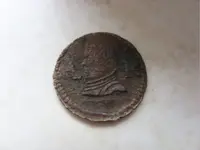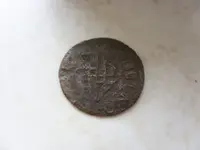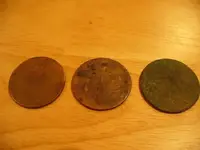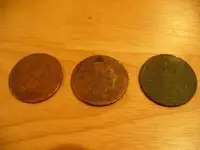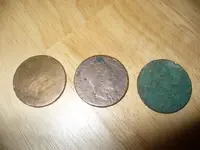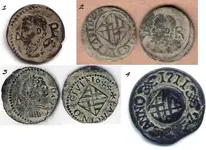Hello friend, these coins are most common to find around here .... some are silver , another is copper (depends on the date and the king) if you have curly collar are silver, which have a straight collar is of copper.
The your coin is of King Philip IV.
These coins are very abundant in my area, but did not circulate in the rest of the empire Español.por this reason in some auction houses are listed for over $ 40 that are in poor condition. (Which sold more economical are illegal sale 4 or $ 5)

1 PIC:
FELIPE III.
These tend to be silver out sometimes in good condition.
LEGEND.
front: AR and half the king's face looking left
back: BARCINO CIVITAS (undated).
others are characterized by presenting the neck twisting.
I know the dates so far are:
1611-1612-1613-1614-1615-1616-1617-1618
-------------------------------------------------- -------------------------------
2 PIC
FELIPE IV
LEGEND.
front: AR and half the king's face looking left
Reverse: CIVITAS BARCINO (date).
Early ARDITES of Philip IV also had curly neck, as you can see here ARDITES in 1624.
The dates that I know so far are:
1624-1625-1626-1627-1628-1629-1630-1631-1632-1633-1634-1635-1636-1637-1640-1653-1654-1655-1661.
The most common are 1654 and 1653 and 1655.
-------------------------------------------------- -----------------------------------------------
3 PIC:
LOUIS XIV
France king and Catalonia king.( Independece Catalan wars in Spain 17th Century )
1644-1647-1648:
-------------------------------------------------- -------------------------------------------------
4 PIC:
CARLOS III WOOER
many have spoken of these ARDITES, which really are counterstamps previous currency, specifically ARDITES of Philip IV and III.
The ARDITES of Charles III "The Pretender" are counterstamps. ARDITES were collected before Philip IV (and III), usually the most common, that is 1653-54 and 55, and reseal top.
It left two central circles where normally you can see the previous ARDITES, the coat of Barcelona (or part thereof) and partially the bust with A and R.
What you see in the central circles are not counterstamps, but the opposite, part of the original currency. The override is the outline of the coin where you can read: 2 Di, B, ANNO, and year of the override, apart from some pretty ornaments.
of all the most common is 1709.
DATES: 1700-1701 1707-1708 -1709-1710-1711
1700: 1709:
1710:1711:

